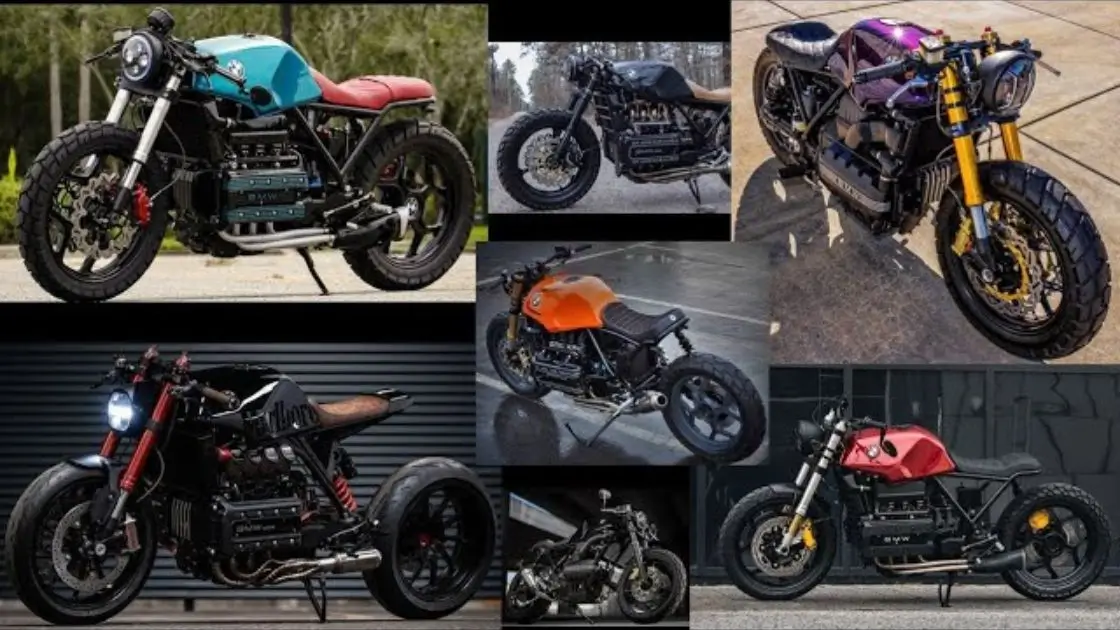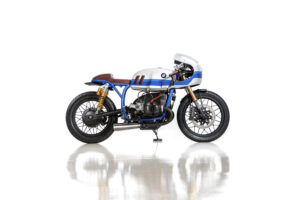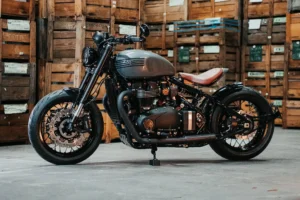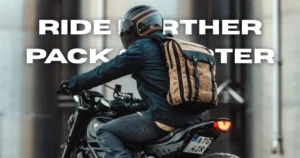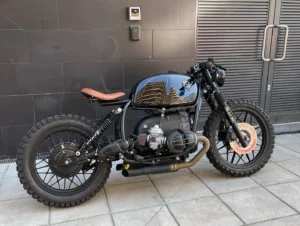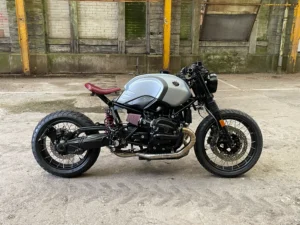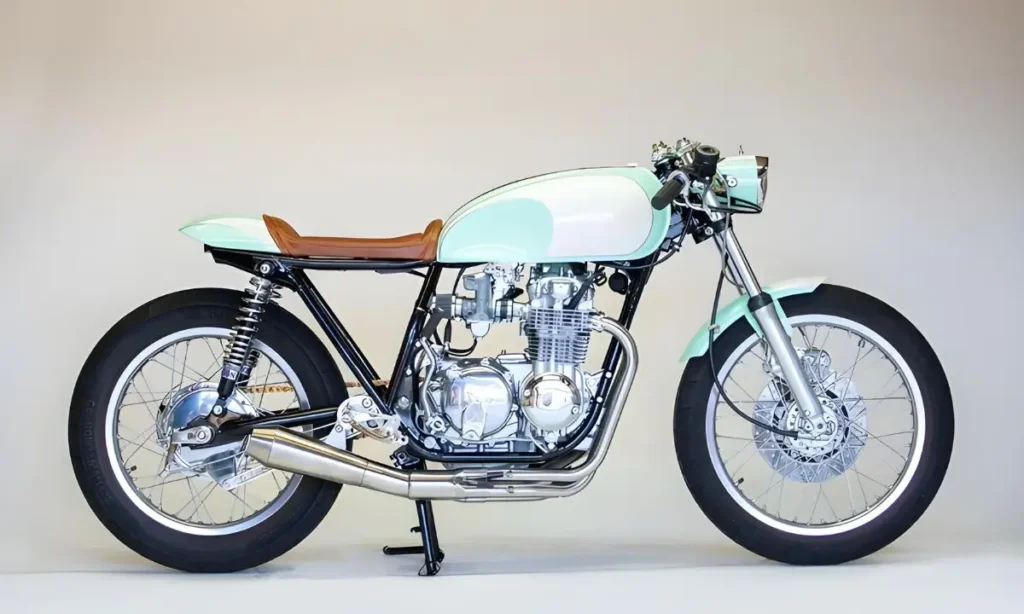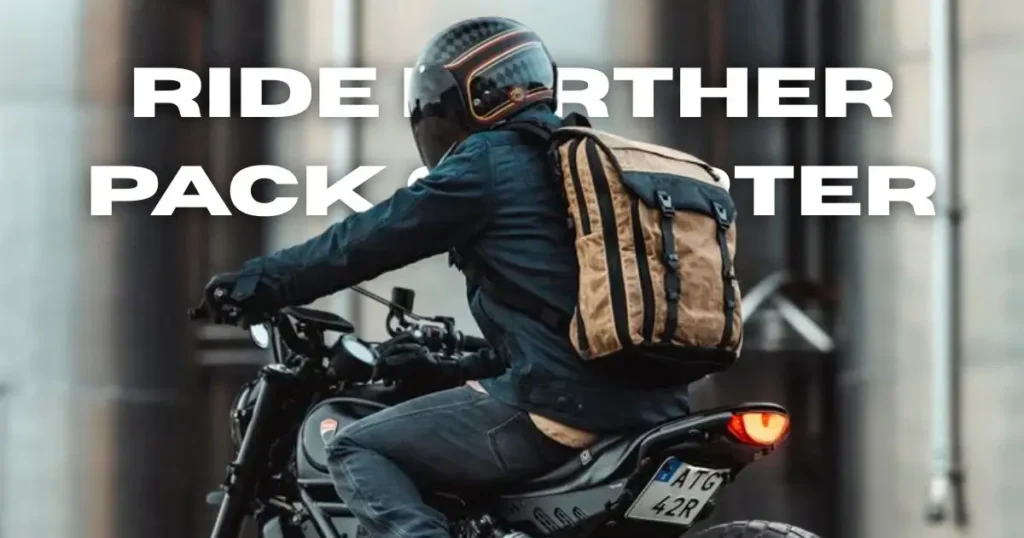Table of Contents
ToggleWhen it comes to building café racers, few bikes can match the charm and versatility of BMW K-series motorcycles. These bikes are known for being reliable and having an innovative design, especially with their unique “flying brick” engine. This makes them perfect for café racer conversions. Whether you are an experienced builder or just starting to modify your bike, BMW K-series bikes provide a strong foundation.

I have spent hours studying different builds, reading forums, and watching these amazing transformations happen. From my experience, choosing the right base bike for your café racer project is crucial. BMW K-series bikes, like the K75, K100, and K1100, are great choices because they are affordable, easy to modify, and perform well. But why are they so ideal for building café racers? Why do so many builders pick these models? And which one should you choose for your next project?
In this article, we will look at the best BMW K-series bikes for building café racers. We’ll also cover key custom modifications, talk about challenges you might face, and show you some of the best BMW K-series café racer builds to inspire your own project. Let’s begin!
Best BMW K-Series Models for Cafe Racer Builds
When picking a BMW K-series bike for a café racer build, you need to think about what each model offers. Each bike in the K-series has its own benefits. Your choice depends on your goal. Are you after lightweight handling, strong power, or a mix of both? Let’s look at the top options: BMW K75, BMW K100, and BMW K1100.
BMW K75: Lightweight and Beginner-Friendly
The BMW K75 is known for being light and easy to handle, making it a top choice for café racer builds. If you’re new to custom bike projects or café racers, the K75 is a great place to start. Its 3-cylinder engine gives it a unique sound and performance without being too powerful or heavy.

Why Choose the BMW K75?
- Lightweight: The K75 weighs less than other K-series models. It’s easier to handle and work on, making it ideal for creating that classic café racer look.
- Affordability: The K75 is often cheaper than the K100 or K1100. It’s more affordable to buy and easier to find spare parts.
- Customizability: The K75 is easy to modify. The 3-cylinder engine gives it a unique look when exposed as part of the build. You can also modify the seat, handlebars, and frame to match your café racer style.
BMW K100: The Middle Ground for Performance and Price
The BMW K100 is one of the most popular bikes for café racer builds. Its 4-cylinder “flying brick” engine offers a great mix of power and customizability. Though heavier than the K75, it delivers more power, making it perfect for those who want extra performance.

Why Choose the BMW K100?
- Power: The K100’s 4-cylinder engine gives more power than the K75. This makes it a good option if you want your café racer to not only look great but also perform well.
- Plenty of Aftermarket Parts: Since the K100 is a favorite for café racer builders, there are many aftermarket parts available. You can easily upgrade the exhaust system, suspension, or fuel system with parts made for this model.
- Classic Aesthetic: The large engine adds character to the bike. When exposed in a café racer build, it becomes a key design feature.
BMW K1100: Power and Performance for Experienced Builders
If you want more power and a modern café racer build, the BMW K1100 is a great choice. With a 4-cylinder engine that’s larger than the K100’s, the K1100 offers more torque and speed. However, it’s also the heaviest of the three models, making it a bit harder to handle and modify.

Why Choose the BMW K1100?
- Powerful Engine: The K1100 has a 1092cc engine, which delivers more power than the K75 and K100. It’s ideal for experienced builders looking for high performance in their café racer.
- Handling: While heavier, the K1100 can be fitted with top-notch suspension and brakes. This makes it perfect for those who want both power and modern café racer handling.
- Customization Potential: Like the K100, the K1100 is popular in the custom bike world. You’ll find plenty of parts and knowledge available to help with your build. It’s a top pick for long-distance café racers because of its comfort and performance.
Now you have an overview of the best BMW K-series models for café racer builds. Each offers something different, so your choice depends on your skills, budget, and performance goals.
Essential Modifications for BMW K Cafe Racers
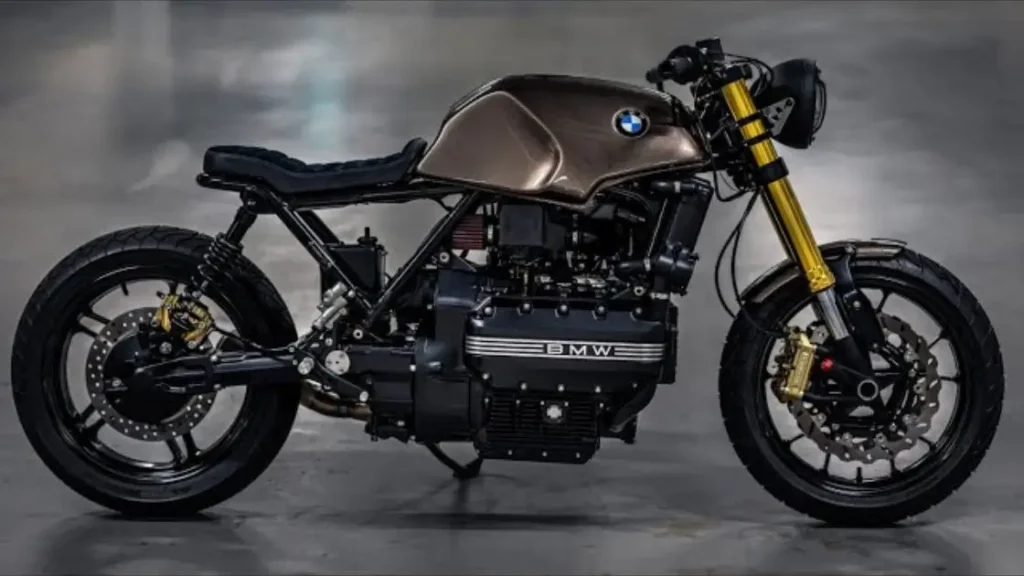
Once you’ve picked the right BMW K bike for your café racer build, the next step is to focus on the key modifications. A café racer is all about simplicity, style, and performance. You’ll need to strip away unnecessary parts, upgrade essential components for better performance, and work on creating that classic café racer look. Here’s a breakdown of the key modifications to turn your BMW K-series into a café racer masterpiece.
Frame and Subframe Adjustments
One of the most important modifications in building a café racer is changing the frame and subframe. Café racers are known for their clean, simple lines, but the stock frame on BMW K-series bikes can be too bulky. You will need to cut and modify the subframe to get the right look.
For the BMW K100 and K75, a common change is cutting off the rear part of the subframe and welding a flat subframe to support a smaller café racer seat. This makes the bike lighter and gives it the sleek, horizontal line that defines a café racer. The BMW K1100 is heavier and may need more work, but with the right tools, you can achieve a similar style.
Subframe Mods Checklist:
- Cut off the rear part of the frame to fit a flat subframe.
- Weld a simple, new subframe to hold the café racer seat.
- Make sure the new subframe is aligned for good handling and comfort.
Engine Modifications
The engine is often the heart of a café racer. With the BMW K-series, the “flying brick” engine is a unique feature that can make your bike stand out. Many builders like to showcase the engine, turning it into the visual centerpiece of the build. While the stock engine in the K100 or K1100 has plenty of power, you can make a few changes to improve performance.
One popular modification is removing the airbox. Many builders replace the bulky airbox with pod filters or velocity stacks. This not only cleans up the look of the bike but also improves airflow to the engine. Pair this with a custom exhaust system for better performance and a deeper, louder sound. The BMW K100 and K1100 are especially suited for these mods due to their strong engines.
Engine Mods Checklist:
- Remove the stock airbox and install pod filters or velocity stacks to improve airflow.
- Upgrade the exhaust system with a custom setup, like a 4-into-1 exhaust.
- Re-tune the engine to work with the new intake and exhaust setup.
Aesthetic Upgrades
A big part of café racer culture is the bike’s appearance. With a BMW K-series, you have a lot of options for creativity. The first step is replacing the stock seat with a slim café racer seat. These seats are usually single-seaters with minimal padding and follow the clean, straight line of the bike.
Next, focus on the fuel tank. The stock tank on a BMW K100 or K75 may look too modern for a classic café racer style, so many builders replace it with a more vintage tank. However, if you like the stock tank, you can give it a custom paint job or add knee pads for a retro look.
Other important upgrades include clip-on handlebars. These replace the higher stock handlebars, giving the bike a lower, more aggressive stance. You’ll also want to install a simple headlight and bar-end mirrors to complete the look.
Aesthetic Mods Checklist:
- Replace the stock seat with a café racer seat.
- Either swap the fuel tank or customize it for a vintage look.
- Install clip-on handlebars for a lower stance.
- Upgrade to a classic round headlight and add bar-end mirrors for a cleaner profile.
Handling and Performance Upgrades
Café racers are built for speed and performance, so it’s important to make sure your BMW K bike handles smoothly. This is where suspension upgrades come in. If you’re working on a heavier model like the K1100, consider lighter forks or upgrading the stock suspension to modern, adjustable ones. The goal is to reduce weight and improve handling for a more responsive ride.
You should also think about upgrading the braking system. Café racers are often stripped down, but safety should not be overlooked. Installing better brake calipers or a new set of disc brakes can greatly improve stopping power.
Handling and Performance Mods Checklist:
- Upgrade the suspension for better ride quality and handling.
- Install modern brake calipers and rotors for stronger braking.
- Consider upgrading to high-performance or café racer-specific tires.
These upgrades will help turn your BMW K-series bike into a true café racer. Whether you want better performance, a vintage look, or a sleeker ride, these modifications are essential.
Next, we’ll explore common challenges and how to overcome them.
Challenges and Solutions
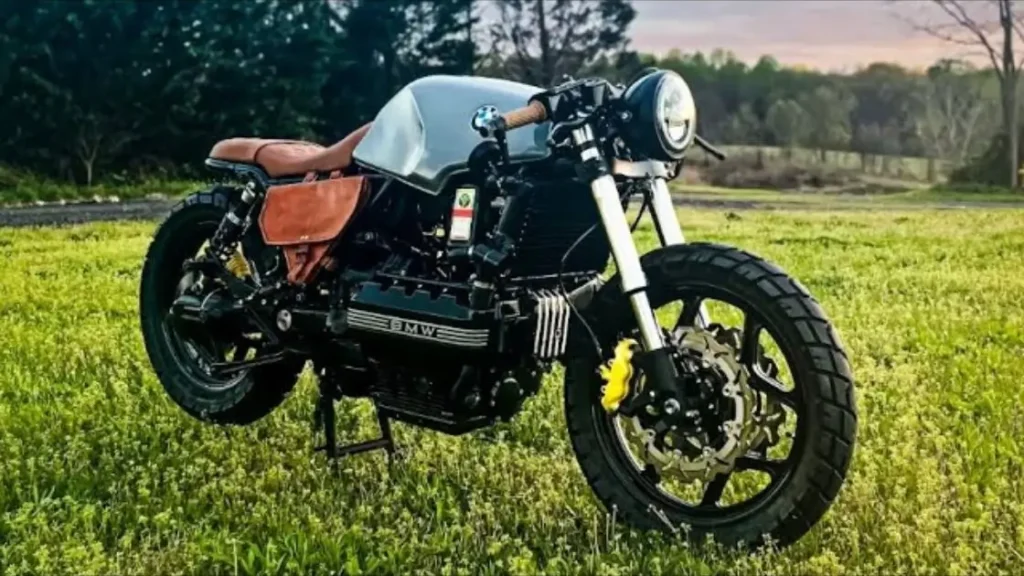
Building a café racer from a BMW K-series bike is rewarding but comes with challenges. Whether you’re working with a K75, K100, or K1100, there are common obstacles you might face. The good news is many builders have documented these challenges, and with some planning and creativity, you can overcome them. Here’s a look at some common issues and practical solutions for your café racer build.
1. Heavy Frame Weight
One of the most common issues with the BMW K-series, especially the K100 and K1100, is their weight. These bikes were designed more for long-distance touring than for lightweight racing. The K1100, for example, can weigh over 500 pounds, which is a lot when building a café racer.
Solution: Weight Reduction
To reduce weight, you’ll need to remove non-essential parts. Start by taking off the fairings, luggage racks, and any touring accessories. Replace heavy parts like the seat, subframe, and exhaust with lighter, custom alternatives. Many builders choose aluminum or carbon fiber parts to cut as much weight as possible. You can also modify the frame and subframe, as discussed earlier, to make the bike lighter.
Key Tips:
- Remove non-essential parts like fairings, side covers, and stock lighting.
- Use lighter materials, like aluminum, for custom parts.
- Take a minimalist approach to each part of the build.
2. Unique Engine Shape
The “flying brick” engine in BMW K-series bikes is both a strength and a challenge. It’s reliable and has a distinctive look that sets it apart from other café racers. However, its large, boxy shape can make it harder to achieve the sleek, minimalist style that café racers are known for.
Solution: Embrace the Engine
Instead of trying to hide the engine, make it a key part of your design. Many builders highlight the engine by removing as many parts around it as possible, making it the centerpiece of the bike. You can also use custom side covers or paint to blend the engine into your overall design. Exposed engine parts like crankcase covers can give your build a unique, industrial look.
Key Tips:
- Make the engine the visual centerpiece of your build.
- Use custom side covers or paint to match the engine to your design.
- Highlight crankcase and camshaft covers for a rugged, industrial style.
3. Stock Electronics and Dashboard
The BMW K-series bikes, especially the K100 and K1100, have outdated electronics and dashboard displays. The stock dashboard is bulky and doesn’t fit the sleek, minimalist style of a café racer. The wiring can also be tricky, especially when you start replacing parts.
Solution: Modernize the Electronics
Many builders choose to replace the entire electrical system. This includes installing a modern, simpler wiring harness and swapping the stock dashboard for a minimalist digital speedometer. Upgrading to LED lights will reduce power use and give the bike a more modern look. If you’re not confident with electrical work, it’s a good idea to consult a professional or follow detailed guides from the café racer community.
Key Tips:
- Replace the stock dashboard with a smaller digital version.
- Upgrade to LED lights for better efficiency and a modern style.
- Simplify the wiring harness for a cleaner, easier setup.
4. Achieving the Right Stance
A café racer’s stance is all about having a low, aggressive look. While BMW K-series bikes offer a good base, the stock suspension and high handlebars may not give you the café racer posture you want. To achieve the right geometry, you’ll need to adjust both the suspension and handlebars.
Solution: Lower the Front Forks and Add Clip-Ons
To lower the front, many builders drop the front forks slightly. This gives the bike a more forward-leaning stance. Pair this with clip-on handlebars, which are mounted lower on the forks than the stock ones, and you’ll get the café racer geometry you’re after. For the rear suspension, upgrade to modern shocks for more adjustability in height and stiffness.
Key Tips:
- Lower the front forks for a more aggressive stance.
- Install clip-on handlebars for a lower, sportier posture.
- Upgrade to modern rear shocks for better handling and adjustability.
5. Finding the Right Parts
The BMW K-series isn’t as common in the café racer scene as older Triumphs or Hondas. Because of this, it can be harder to find the right aftermarket parts. Whether you need a custom seat, tank, or specific engine parts, you might have to search more to find ones that fit.
Solution: Tap into the Café Racer Community
Fortunately, there is a strong community of BMW K-series builders who love to share their knowledge. Forums, YouTube channels, and custom bike websites are great places to find parts and advice. Many custom fabricators also specialize in BMW K-series builds and can create unique parts for your bike.
Key Tips:
- Search café racer forums and groups to find specific parts.
- Look for fabricators who specialize in BMW K-series components.
- Get creative and modify parts to fit your build.
Popular Custom BMW K Builds
Now that we’ve covered the best models, modifications, and challenges, it’s time to find inspiration. The café racer world is full of amazing BMW K-series builds. These custom bikes show what’s possible and can give you ideas for your own project. Below are some standout BMW K café racers known for their design, performance, and craftsmanship.
The KAgusta BMW K1200RS
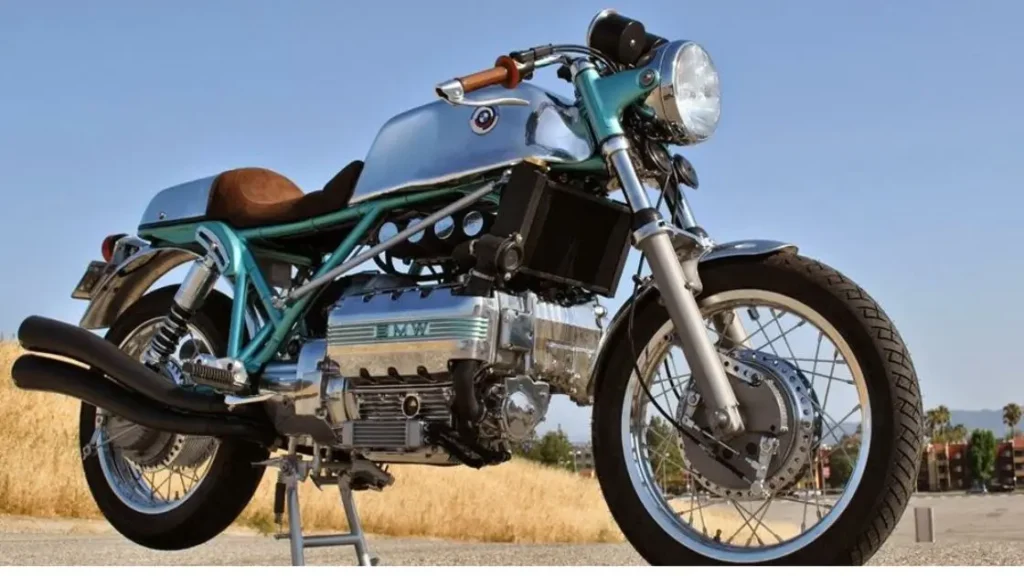
Photo Credit- 1000ps.at
One of the most impressive café racer builds in recent years is the KAgusta BMW K1200RS. This bike was built to celebrate the 100th anniversary of Irv Seaver Motorcycles and transformed by BMW K expert Larry Romestant. The KAgusta combines elements from 60s and 70s German, British, and Italian café racers, influenced by brands like MV Agusta and Ducati.
The builder modified the frame to fit the K1200RS engine, added a custom 4-into-1 exhaust, and upgraded the bike with modern parts like Brembo brakes and Tarozzi aluminum fork braces. The result is a beautiful mix of classic café racer style with modern engineering.
Key Features:
- Custom Frame: Modified to fit the K1200RS engine and components from BMW and Ducati.
- Unique Aesthetic: Inspired by classic European café racers, with hand-built parts and custom paint.
- Performance Upgrades: Includes Brembo brakes, custom suspension, and a modern electronic system.
BMW K100 by Ed Turner

Photo Credit- pipeburn
Another impressive build is the BMW K100 café racer by Ed Turner. This bike showcases what can be achieved by embracing the industrial look of the K100’s “flying brick” engine. Turner highlighted the raw, muscular design by exposing both the engine and frame, while adding sleek modern touches.
One of the standout features is the custom seat and subframe, which completely changes the bike’s silhouette. Turner also upgraded the exhaust system, choosing a minimalist setup that improves performance and gives the bike a unique sound. This build shows that even the bulky K100 can look sleek and aggressive with the right approach.
Key Features:
- Raw Industrial Design: Exposed engine and simple modifications that enhance the bike’s natural shape.
- Custom Seat and Subframe: Lowered and slimmed down to create a classic café racer stance.
- Upgraded Exhaust: A custom minimalist exhaust that boosts both performance and sound.
BMW K75 by Tom Racing Designs

Photo Credit- tomracingdesigns
For those who prefer the lighter BMW K75, the Tom Racing Designs K75 café racer is a standout example. This build focuses on weight reduction and a clean, minimalist look. The builder stripped the bike down to its essentials, removing unnecessary parts and making key modifications to the frame and suspension for a low, agile stance.
The most notable feature is the custom exhaust and seat. The builder chose a slim, flat tracker-style seat that complements the exposed engine and lowered front forks. This K75 shows how a relatively affordable bike can become a stylish and capable café racer.
Key Features:
- Lightweight Build: Reduced weight by removing non-essential parts and using lighter materials.
- Slim Seat and Low Stance: A flat tracker-style seat that enhances the bike’s clean lines.
- Custom Exhaust: Adds a unique sound and fits the bike’s stripped-down look.
BMW K1100 Café Racer by M Performance
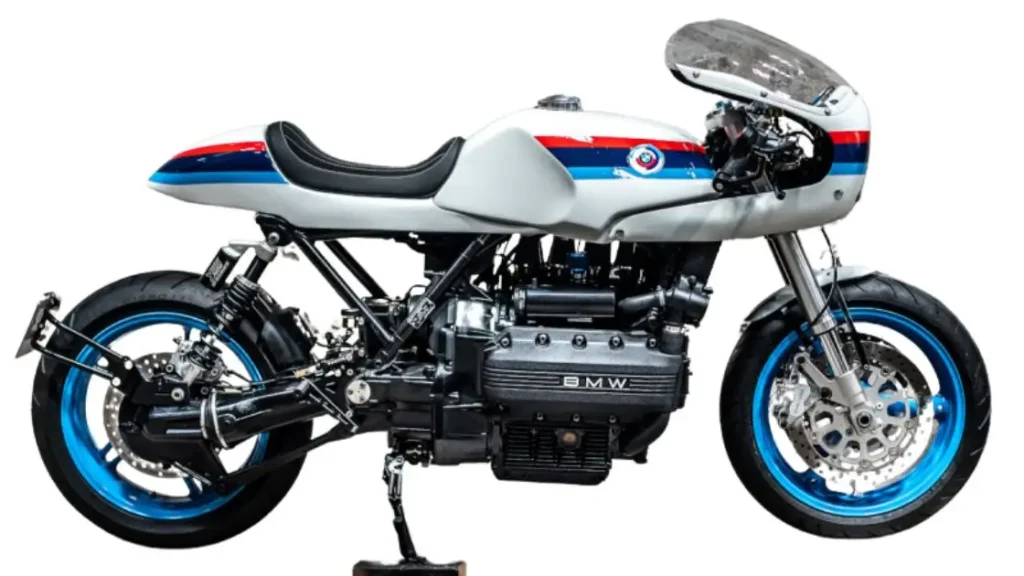
For those looking for power and style, the BMW K1100 Café Racer by M Performance is a stunning example of what’s possible with larger K-series bikes. This build includes a full engine rebuild, custom stainless steel exhaust, and a retro-inspired paint job, drawing inspiration from BMW’s iconic M series.
One major upgrade is the custom suspension, which improves handling, especially with the heavier K1100. The builder also added a digital speedometer and LED lighting, combining modern features with a vintage look.
Key Features:
- Powerful Engine: Fully rebuilt and tuned for better performance.
- Custom Exhaust and Suspension: Modern components that enhance both performance and handling.
- Retro Styling: M-series-inspired paint job blending classic and modern aesthetics.
These custom builds showcase the range of possibilities with BMW K-series bikes. Whether you prefer the lightweight K75, the powerful K1100, or the versatile K100, there’s plenty of inspiration for your own café racer project. Each builder took a unique approach, balancing form and function to make their bikes stand out in the custom café racer scene.
Conclusion
Building a café racer from a BMW K-series bike is a rewarding project. It lets you mix performance, style, and creativity. Whether you’re an experienced builder or just starting, the BMW K-series is a great choice for custom modifications.
From the lightweight BMW K75 to the powerful BMW K100 and high-performance BMW K1100, each bike has its own strengths. The choice depends on what you want—whether it’s agility, power, or a mix of both.
To build a café racer, you’ll need to know the essential modifications. These include adjusting the subframe, updating the engine and electronics, and giving the bike a classic café racer look. You will face challenges like the bike’s weight, the engine’s unusual shape, or finding the right parts. But with persistence, you can overcome these issues and create a unique café racer.
The custom BMW K-series café racers we reviewed—like the KAgusta BMW K1200RS, BMW K100 by Ed Turner, and the BMW K75 by Tom Racing Designs—show what’s possible with the right modifications and a creative vision. These bikes are great examples of how you can achieve different styles, from a minimalist look to a performance-focused design.
In the end, building a café racer is about making the bike your own. No two café racers are the same, and your BMW K-series café racer will reflect your style and skill.
Disclaimer:
This article provides information for learning about BMW K-series café racer builds. The content is based on research, personal experiences, and industry knowledge. While we try to ensure the information is accurate, it should not be taken as professional advice. Modifying motorcycles needs mechanical skills and can be risky. Always check with a skilled mechanic or custom bike expert before making any modifications. The author and publisher are not responsible for any damage, injury, or legal issues from using the information in this article. Use the advice at your own risk and always follow safety precautions when working on your motorcycle.
FAQs
What’s the best BMW K model for beginners building a café racer?
For beginners, the BMW K75 is a great choice. It’s lighter, cheaper, and easier to handle than the K100 or K1100. The K75’s 3-cylinder engine gives a good mix of power without being too much. This makes it perfect for anyone starting their café racer build.
Can I build a café racer with a BMW K1100 even though it’s heavy?
Yes, you can. The BMW K1100 is heavier, but it still makes a great café racer with some changes. You’ll need to remove extra parts and add lighter pieces like a custom exhaust or subframe. The powerful engine makes it a good fit for more experienced builders who want high performance.
What tools do I need to modify a BMW K bike into a café racer?
You’ll need basic tools like wrenches, screwdrivers, and a socket set. For more advanced changes like cutting the subframe or fixing electronics, you’ll need a welder, grinders, and electrical tools. These will help with deeper customizations, such as adjusting the frame or adding a new speedometer.
Should I upgrade the brakes on my BMW K café racer?
It’s a good idea. The brakes on older BMW K-series bikes may not work well for faster speeds. Adding modern brake calipers and rotors or using Brembo brakes can greatly improve stopping power. This makes your bike safer and more responsive.
Can I build a café racer without removing the airbox?
Yes, it’s possible, but many builders prefer to take the airbox out and use pod filters or velocity stacks. This helps the engine get more air and gives the bike a cleaner, simpler look, which is key for café racers. But it’s up to your build’s style and goals.
How much should I budget for a BMW K-series café racer build?
Costs depend on how much customization you plan to do. For basic changes like a new seat, handlebars, and minor tweaks, expect to spend around $1,500 – $3,000. For bigger changes like a custom exhaust and major frame work, it could cost $5,000 or more.
How hard is it to maintain a BMW K café racer after building it?
BMW K-series bikes are known for being reliable, so they don’t need much upkeep once they’re built. However, custom parts may need more regular checks. Things like suspension, brakes, and engine upgrades will need regular maintenance like oil changes and tuning to keep the bike running well.

